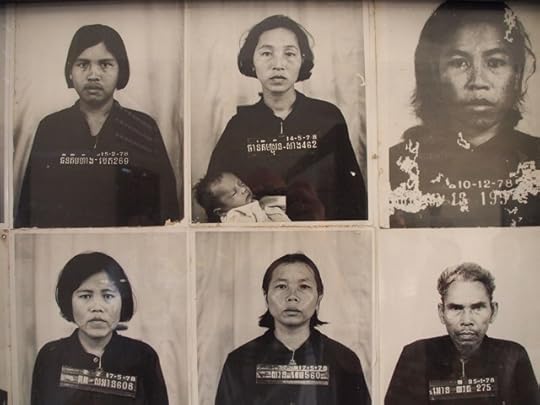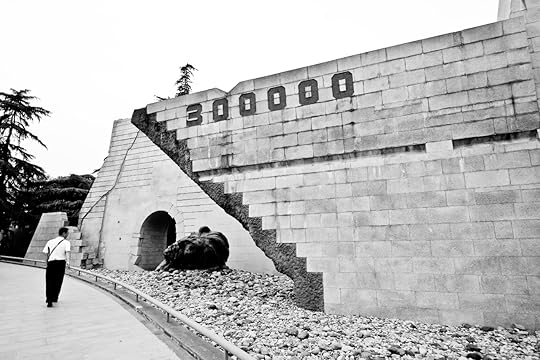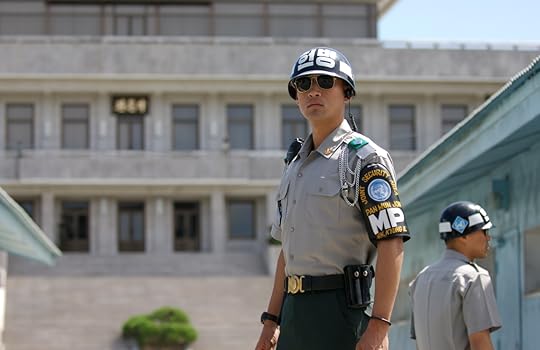Matador Network's Blog, page 2159
January 18, 2015
10 stunning images of Hawaii's ocean
Editor’s note: Anianikū (ani-ani-koo) Chong is a native Hawaiian living on the Big Island. He’s an explorer and a photographer, and one of his most central muses is the ocean. This piece explores the role the ocean plays in the lives of Hawaiians. 

1
The Pacific
We watch the sun rise and set on it each day; it watches all our comings and goings. We drive to work alongside it, to our families, into the city, to the surf, and back again. It's around every corner; it's the view from each peak. It is a constant in the life of a Hawaiian, as constant as breathing. For those of us born here, we encounter the ocean often within our first year and it becomes a part of us; it's under our skin, it's in our blood. The ocean is practically part of our family, ever-present in our childhoods, our youths, each day of our lives.

2
The Consumption
Hawaiians literally allow the ocean to consume us. There is safety and comfort there, though we know there are dangers that are at hand. This comfort is due in part to the fact that our ancestors have lived off of the ocean for thousands of years in a hundred different ways. The ocean has sustained our people since we first left Tahiti and the Society Islands, and her wares have graced our dining tables for just as long, and still do. We fish, we spearfish, we trap, we net, we hunt — and then we eat. Fish and seafood has been our diet longer than history can record, from caught fish, to traditional poke, to fish tacos (whether you swear by Pat's, Pupukea, Sweet Home Waimanalo, or the dozens of others), she has fed us well. Thus, there is comfort in being surrounded by her, knowing all she has given, and still gives, to us.

3
The Underworld
There is another Hawaii — in fact, there are many faces of Hawaii — but one of our favorites exists under the surface. Consumed by the warm and clear Pacific, we can see life in a different light. We can see the rhythm of nature in the flurry of a thousand fish, or occasionally in the sombre silence of one single predator. We watch light dance, witness the movements of the waves from below, see the feet of surfers, listen to the dull roar of a passing boat. Life, from the other side.
Intermission
144
15 signs you were born and raised in Monterrey
by Iliana Garcia
13
11 places to swim with whale sharks [PICS]
by Keph Senett
On surviving a shark attack and coming back stronger than ever
by Reid Levin

4
The Wild
There is much that we don't hunt but revere and respect. There is a recognition that we are not alone on in this place, but we are simply being allowed to share it, to borrow it. Koholā (humpback whale), manō (tiger shark), nai'a (dolphin), honu (green sea turtle) are among the life we find under the surface. Surfers, snorkelers, scuba divers, free divers, fishermen, and all of us who enter the ocean here do not confuse respect with fear, but rather keep distances, when necessary, fueled mostly a deep and humble appreciation for the ocean's power, and its inhabitants.

5
The Halfway
It's another place we love to be, we Hawaiians. Body in the ocean, floating, supported, warm and weightless, but face to the sky. To see and experience both sides at once. The roll of the waves, the deep green of the hills, the sheer and sharp drops of the cliffs, the deep blue below, the community together in the surf — it's the perfect place to be. It feels like home.

6
The Crest
As Inuit have many words for types of snow, Hawaiians have words for types of waves: nalu is an ocean wave; nalu haʻi is a breaking wave; nalu kua loloa is a long wave; nalu haʻi lala breaks diagonally, and so forth. We are content to simply watch the waves, but we are happiest in them. Even those that don't surf with boards but with bodies, or simply paddle along, the rhythm of the ocean rolling under us is something we long for.

7
The Ride
For those that do surf, the ride is almost unmatched by any other experience in life. Even those who don't surf feel a connection to it because surfing has been a part of our world since before we even arrived to these islands. From royalty to the common people, cave paintings to oral histories, we know that surfing has been part of our culture since we arrived here; we feel it in our veins. It's not just about ancestral bloodlines — nearly all of us are a mix and many are not ethically Hawaiian but are born and raised here; it's about toes in the sand, the wind and waves, that sense that roots are growing out from under your feet and into this place — and that its roots are growing into you. We feel that as we carve down the face of a nalu ha'i: we feel harmony with the ocean; we feel humbled by its raw power; we feel reverence for the animals and the world within it; we feel grateful. In the earliest days of Hawaii, there would be a sacrifice and a ceremony at the tree that was about to give us a board.

8
The Shore
Second to being in the water is watching the water. For most of us, the workday begins or ends with a trip to the shore. The ocean brings us a calmness and a peace, a true lift of the spirit. We rise early to greet the day (and catch waves before work), and we stay late. To begin or unwind a day, to receive and to let go. To fish, to watch the surf, to sit. To watch the sun rise and set again. To sink our feet into the sand and reconnect. To come home.

9
The Rage
While many picture the Hawaii of postcards — baby blue sky and white sand — we who live here see all sides of her. For many of us, it's not the picture perfect days that impress us, it's watching the ocean and sky rage against each other, set against the dramatic backdrop of our cliffs and valleys. It is humbling — it reminds us that we are small, and we are lucky to be here.

10
The Setting
The sun dips. The colors arrive. This is our escape and our arrival. Not only do we love to watch the sun set, but the ocean is literally a setting for our lives. We grow up here, our past and future are here, our days and weekends and mornings and evenings take place here, our friends and our roots are here. There is no other place we long to be.
January 17, 2015
Why bartenders are the greatest people to go out with

Photo: CEBImageryl
GOING OUT with a bartender has its upsides, for sure. Believe it or not, we don’t all fit the stigma of ‘players’ or ‘party girls’. Let’s clear up some negative misconceptions and discuss why us bartenders are the greatest people to go out with, shall we?
1. We know when and where the hottest parties and restaurants in the city are.
2. At these parties and restaurants we never wait in line or pay cover.
3. We are on the receiving end of a lot of empty lip service and drunken flirtations at work, therefore we appreciate relationships of substance at home.
4. Intoxicated patrons are not appealing, so we don’t find it difficult to stay loyal (believe it or not).
5. We can get you free drinks AND free cover.
6. We know all the best places for late night eats.
7. Bartending gives us enough time to go to school or work an entry level job and not have to stress about money.
8. Because we are always working when everyone else is partying, we stay out of trouble and save our money.
9. We have a flexible schedule. Tuesday matinee date? Done.
10. We have mastered small talk and know how to charm all types of people. Your parents will love us.
11. We have the best stories about celebrity encounters and crazy customers.
12. We know our liquor products, therefore we can recommend the best whiskeys or wines on the menu for you.
13. We always have cash on us.
14. We’ve seen it all and are able to keep our cool in the most ridiculous circumstances.
15. We are the hardest workers you know.
16. We are attracted to confident people who can handle us flirting with customers because they understand it’s part of our job. (Dating a bartender isn’t for the insecure.)
17. We treat others in the service industry with respect and will always tip well.
18. We often have dreams beyond bartending. Just look at former bartenders Mark Cuban, Sandra Bullock, and Bruce Willis who all poured drinks as they pursued their careers. Many other bartenders open their own establishments. Even if bartending isn’t our dream job, it’s an honest living.
19. There’s no shortage of having nights to yourself or with your pals because we are stuck working.
20. It’s not weird for you to swing by our work. Just don’t get too drunk.
21. We are so used to taking care of guests that we are very appreciative when someone wants to buy us a drink – other than at our bar. 
What NOT to do in Prague

Photo: Jirka Matousek
Here are 6 steps to avoiding tourist traps, shady drug dealers, and overpriced bagels in Prague:
1. STOP going to Lucerna Music Bar.
Most of the Czechs I know try to avoid Lucerna’s overpriced bar and tourist-infested dance floor. Expats.cz said it was convenient to Wenceslas Square, but it took me almost four months to find the front door.
Instead, go to Futurum.
“We’re going to go dancing at Futurum tonight!” my friend Lenka told me one day after class. Based on her enthusiasm, I concluded that Futurum is where locals go for a crazy night out.
While singing along to Aqua’s “Barbie Girl” (“I’m impressed you know all the words!” said Lenka), I witnessed some dude groping a woman under her shirt. She didn’t seem to mind the PDA. They just kept dancing. Because that’s the kind of place Futurum is.
2. STOP going to Cross Club.
You know that spot in your town “everybody” goes to that seems cool at first, but really isn’t that cool, and after a while you realize that the kind of people who go there are people you don’t really like? Cross Club is that place.
Tourists flock here, hoping to buy drugs from the shady dealers hanging around the bathrooms, and while the live music is a nice touch, moshing with NYU students all night gets old.
Instead, go to Radost FX.
I’ve eaten vegetarian food, sipped on cappuccinos, rifled through used CDs, and partied my ass off in an underground club — all within the same building at Radost FX. I discovered this cafe / vegetarian restaurant / second-hand record shop / discotheque while getting lost in my neighborhood, Vinohrady.
I don’t even mind when tourists show up, because Radost’s multiple venues make it easy to avoid them.
3. STOP shopping on Wenceslas Square.
Václavské náměstí is an important Czech historic site, but none of the retail shop brands lining the boulevard are Czech. I thought I would, at least, score some deals due to the country’s low exchange rate, but in doing the math, a pair of sneakers found at my local mall cost almost twice as much in Prague.
Instead, shop off the beaten path.

Prague’s Old Town Square. Photo: Florin Draghici
One-of-a-kind pieces from some of Prague’s own designers cost me pennies — all found while strolling down alleyways and taking side streets off the main tourist areas.
Le Boheme is my favorite find, a funky little shop near Old Town Square where, after being fitted for a custom blazer, I watched owner Renáta Vokáčová construct new designs in the back of her shop. Even one of the city’s most famous designers, Helena Fejková, offers couture fashion for considerably less than any other designer I’ve ever met.
4. STOP going to Bohemia Bagel.
I thought bagels were an Eastern European thing, and that I’d be swimming in them in Prague, but that hasn’t been the case. Stopping by this expat joint one day, I wasn’t impressed by the nearly $2 poppy seed bagel with cream cheese. I didn’t come to Prague to eat Caesar salads, Philly cheese steaks, and brownies anyway.
Instead, go to Cafe Savoy.

Photo: Estefanía Trisotti
Located near my favorite bridge, Most Legií, Cafe Savoy’s interior has been restored to its turn-of-the-century architectural glory. I’ve traded Bohemia Bagel’s free wifi and takeaway coffee cups for Savoy’s decadent plates of food, pâtisseries, and creamy café au lait.
5. STOP going to Starbucks.
Seriously. Stop it. The flagship location replaced Café Radetzky, a 135-year-old teahouse Franz Kafka used to frequent, so a little bit of Czech history died with your latte.
Instead, go to Krásný Ztráty.
Krásný’s cafe drinks and snacks are satisfying after a day spent studying next to Václav Havel. No joke, I was writing a paper in Krásný’s quiet back room, the former president and playwright sitting adjacent to me with a cup of coffee and a newspaper.
It’s pretty easy to meet famous Czech people if you go to the places Czechs like to hang out. Perhaps you’ll get lucky and spot the current President of the Czech Republic, Miloš Zeman, with a milkshake and a comic book.
6. STOP going to Charles Bridge during the day.
Charles Bridge isn’t that long of a bridge, but it takes over an hour to cross during the day because of the crowds. I made the mistake of using it on one of my first days in Prague, and felt like a calf in a herd of tourists.
Instead, go in the early morning or late evening.

Photo: Roman Boed
The crowds thin out between 11PM and 7AM. Crossing the bridge off-hours makes it easy to stop and rub all the good-luck statues. The brick walkway is particularly nice for a stroll after a night of drinking. 
This article was originally published on July 3rd, 2012.
Top 10 surf spots for in Hawaii

Photo by Scott Schiller
HAWAII IS THE MOST geographically isolated landmass on the planet, and for some that means only one thing: groundswell.
Everywhere, in every direction, the currents of the Pacific are churning up the winds, storms, and fetch that ultimately source these islands with their world class waves. Below is a list of the best places to get wet if you have never been to Hawaii.
To be sure, there are far better waves than those listed below, but they are unlistable for various reasons. Take Kauai, for instance; there is nothing more to hide – the world already knows what waves exist, just look at a map, but why then is any photo of Kauai’s best wave still flipped, and never named, when it’s printed in any surf mag?
Because respect is a crucial element of the Hawaiian surfing experience; and with reason – the island juice is no myth; ocean conditions here are worlds away from your local beach break.
But still, come surf, it’s Hawaii, the Duke would have wanted you to. For the full rundown of breaks, grab “Frank’s Map” at any surf shop. In no particular order….

Photo by Romain Guy
Ehukai Beach Park (North Shore, Oahu)
Straight out from the parking lot of the same name, are several shifting peaks that work on everything from a west to a windswell wrap from the east. Sandy bottom is scattered with random fingers of rock. Generally a good place to come if you are beyond a beginner, but still getting used to things.
Great place to get the feel of Oahu’s North Shore. Pipeline is immediately to the left, and when it’s big enough, it essentially swallows all the peaks of the beach park. Come here to watch Pipe or sight Tom Curren; across from Sunset Beach Elementary.
Laniakea (North Shore, Oahu)
On a big north, Lani’s is a freight train right that can connect for an extremely long, fast ride, with four or five makeable sections. Deep water wave, but still barrels with the right conditions. Very consistent with any swell that has a bit of north in it; doesn’t work at all on pure west swells.
Good place if you’re looking to blend in – the “town” crowd from Honolulu loves this wave, and thus there are always different faces in the water. There is a shorter, hollow left as well, that can be very fun. Seen in the big opening along Kam Hwy as you head east from Hale’iwa. Caution: parking lot thieves run amuck.

Photo by Kanaka Menehune
Backyards (North Shore, Oahu)
The first time I surfed ‘Yards it went from a playful head high to a widow-making triple-overhead in 40 minutes, and I had to paddle out and around the entire point in a heap of anxiety to get in, so take note.
Very fast, advanced wave with a steep wall, thick lip, and shallow reef below. Good barrels. Swell magnet from all directions, but works best on a NW swell. Can get very, very big, and often has less of a crowd than other spots. Further out on the point from Sunset. Access from the shallows at the tip of the point.
Caution: reef, clean up sets.
Sunset (North Shore, Oahu)
Sunset is one of the most fabled right hand points there is, and thus attracts many a soul the world over. In that sense, you can surf it without worry (crowd-wise) if you let your hyper-paddling habits subside. Surely not a wave to be taken lightly though, even at a playful three feet Hawaiian. The wave turns very fast and hollow as it emerges and walls up quick from deep water; famous inside bowl throws way out for a good, heavy barrel.
You need some length and paddling strength in your board here; very thick wave and can be difficult to get into. Prepare yourself to get washed and bashed around on the reef when you see that rogue set swing wide from the west; you’ll certainly be caught inside.
Caution: shallow reef, heavy lip, clean-up sets.

Photo by Kanaka Menehune
Hookipa (Paia, Maui)
Between Haiku and Paia is Maui’s most consistent wave, or waves, and it happens to double as one of the best windsurfing spots in the world. All the various peaks can be seen from the bluff along the Hana Hwy heading east from Paia. The most hierarchical spot is Pavillions, the right that comes off the far east point; otherwise, there is much range of skill found in the lineups of the other peaks; still, keep respect.
Catches everything from the big WNW’s to the easterly windswells. Very exposed to the wind, so get up early before the wind does, and then hit it again late in the afternoon; with Kona winds, you score! Park in the parking lot below the bluff, and follow someone else into the water (and out).
Honolua (North Shore, Maui)
Honolua is one of the magical waves of the world, a flawless right point that seems to peel into infinity – when you happen to catch one. The crowd here is dense, but the joy of one ride makes it all worth it, especially that crisp barrel through the cave section.
Somewhat sheltered from the islands to the north, the swell window here is smaller than most other spots, and thus it works much less often; best on a big NNW swell. The trades that plague most of the rest of Maui, work fine here, to make a consistent side-offshore breeze. Again, when you connect one, the wave is simply magical.
Park on the bluff above, follow someone out.

Photo by Daniel Ramirez
Velzyland (North Shore, Oahu)
Everything considered, VLand is probably the most risky inclusion on this list. Shallow, extra sharp reef, a heavily localized pack, and a barrel that seems to suck dry, make for a serious North Shore experience. Respect here (for everything) is vital.
This marks the end of the “seven mile miracle,” the opposite end being Haleiwa’s Ali’i Beach Park. Park along Kam Hwy, and walk through the gate at Sunset Beach Colony. Paddle out from directly in front of the peak. The wide open barrel is unreal, but caution: sharp reef, shallow, crowd factor, locals.
Hanalei (North Shore, Kauai)
This is maybe the only wave on Kauai that you are allowed to mention in a public arena. Lucky for us, it’s a great wave, a peeling right point that works on most winter swell directions. Good fun when it’s smaller to grab a longboard and go make friends in the lineup – then you might find out about those other waves around the way. The bay here is pristine, and so is the town by the same name. On the far north east side of the point, towards the Princeville. Can get very big, and very good.
Canoes (South Shore, Oahu)
This is the jumping off point for the Waikiki surf adventure, and the rest of the south shore as well. Every surfer must come at least once, and there are few waves as friendly to teach your new ladyfriend. While generally a friendly wave, this whole shore turns on several times a summer, firing off exceptional waves. Those roadbumps beneath your board are not coral heads – they’re either the innocently ignorant Japanese tourists, or the equally benign, pasty-white Oklahomans.
On the south shore you can surf fifteen different spots in a single session, so paddle around and explore – that’s what the Duke did. Straight out, fittingly, from the Duke Kahanamoku statue in Waikiki. For more juice on this side of the island, seek Bowls, Kaisers, or the wave in between the two, aptly named Inbetweens. Looking out towards Diamond Head, imagine the Hawaiian legend of the wave the Duke caught way out on the point and connected all the way to the sand, right where you get your favorite mai-tai – the restaurant by the name of Duke’s. 
This article was originally published on November 20, 2007.
How to impress your girlfriend while traveling
Follow Matador on Vimeo
Follow Matador on YouTube
DESPITE being thousands of miles away, MatadorU student, Tom Boyden, was determined to show his affection for his girlfriend during his seven week trip through Africa and Europe.
“I had never done the long distance thing and I’m not the biggest fan of Skype, so I decided to communicate with Natalie in as many ways as I could fit into my crazy trip through 6 countries. I was traveling solo and filmed all of it on a tripod. Sometimes the footage didn’t always work out as planned…When she saw it on her birthday she had no idea I had been making it. She was pretty ecstatic when I talked to her on the phone.”
“I loved the responses I got from folks after I’d tell them the idea of it. Apparently, I’m a romantic.” 
January 16, 2015
Learning to drink in Cornwall

Photo: Mike Mussard
1. You don’t get why you have to wear shoes into bars in the city.
Shoes!? Heels!? Hello no! You grew up in a beach-to-bar culture, where flip-flops are the normal choice of footwear when going to the pub, and then eventually the local club. Your feet are made to be wild and free and not cooped up in an uncomfortable prison of leather. Quite frankly, you’d rather take your rum and sit on a park bench.
2. Sand in your beer is okay.
Growing up in Cornwall means that misspent youth was spent on the beach slurping the cheapest beer you could get your 18-year-old friend to buy for you from Tesco. Beach drinking = sand in your beer, but that’s okay, you know that it just adds to the texture.
3. Warm beer is okay, too.
Well not okay, but warm beer is better than no beer. Sunny afternoons day drinking on the sand come at a price, and if the price to drink in heaven is warm beer, you’ll take it and not moan.

More like this How to piss off someone from Cornwall
4. You’ve realized nudity is not acceptable out of county.
You can get arrested for that shit, who’d have thought?
5. When you order rum…
…You don’t mean a rum and coke. You’ll have a litre of Captain Morgan’s finest and a bottle of coke to go with it, thanks. You have piracy in your blood after all!
6. You are a cider snob.
Strongbow? Magners? Gesson! You drink only the finest, strongest Cornish cider you can get your hands on. If you’re unfortunate enough to be up north, you’ll pick the one that is made as far south west as you can find — or just go back to the rum.
7. Nobody can beat you at “I have never…”
Picture this, you’re at a festival with your Cornish flag flying high in the middle of your camp, and your northern neighbours pop by to share a swig of jäger and maybe a game of beer pong. Soon, someone will pipe up and mention sitting down in a circle and playing “I have never.” You and your friends all look at each other with that same look — all right lads and ladies, looks like we’re getting shit-faced. This is because you are fully aware of the fact that there isn’t one thing that your new friends can say that at least one of you hasn’t done.
8. You always get the most drunk at other people’s parties.
Apparently getting so drunk you can’t see, isn’t the done thing outside of Cornwall. So when you find yourself out with northern friends from university or new colleagues, you are always dubbed that guy, or “the drunk girl.” But you had a good time — you think.
9. You are the master of day drinking.
Day drinking is something of a Cornish institution. There are even days dedicated to breakfast cider and getting home when the sun is coming back up again the next morning. In order to train for these marathon drinking sessions, you must prepare like an athlete in the run up to a triathlon. By the time Helston’s Flora Day and Mazey Day in Penzance roll around in the spring, you are ready to take on the challenge to beat last year’s total for how many pints of Rattler you can get down you in 24 hours. Preferably without vomming on your friend’s feet. Again.
10. Partying outside of Cornwall usually disappoints.
Nobody outside of Cornwall has heard of the Masked Ball or Love Riot. They do not know that your party mantra revolves around getting loose and seeing just how weird it can get. When you and your buddies leave Cornwall, you tend to get kicked out and banned from bars because they just can’t handle the amount of party you like to bring. And when it’s time to party, we will party hard, right? 
This vid of a backcountry skier and his dog is pure joy
The Shadow Campaign // Sun Dog from DPS SKIS on Vimeo.
Follow Matador on Vimeo
Follow Matador on YouTube
IN the snow-capped peaks overlooking Bariloche, Argentina, Refugio Frey is the only protection from the ravaging winds, drawing wanderers of all sorts to its doors.
When a dog named Conga arrives and leads skier Santiago Guzman into the hills with her infectious energy, the windswept landscape becomes a backdrop for the pure joy of two mountain souls sharing a day in the wild. 
How to piss off someone from Illinois

Photo: Tony Delgrosso
Pronounce the “s” in “Illinois.”
I thought this would be just plain common sense, but you should see the looks on my friends’ faces when an outsider refers to their homeland as “Illinoize.” Even I can’t help but wonder if these lunatics are just messing with us. The “s” is silent, people.
Assume that everyone is from Chicago
There is a whole state under Chicago. Literally the entire state. This is how this conversation usually goes down:
“Where are you from?”
“Illinois.”
“Oh, cool! Chicago!”
“Actually, I’m from Mt. Vernon, which is closer to St. Louis, so…”
And no, everything below I-90 is not just “northern Kentucky.”
Assume that the Windy City is always windy
Nope. Just nope. In fact, Chicago isn’t windier than any other city in the US.
Here’s a history lesson for you non-natives: Chicago got its nickname back in the 1800s from a former editor of the New York Sun who was referring to all of its full-of-hot-air-politicians. Even a semi-Illinoisan would know that.

More like this How to piss off someone from Wisconsin
Call it the Willis Tower
It’s the Sears Tower. SEARS. S-E-A-R-S. Just because the sign now reads “Willis” doesn’t mean you should call it that.
Put ketchup on a hotdog
To most northern Illinoisans this is an act akin to selling your soul to the devil or committing a mortal sin.
Mustard is cool, though.
Claim that the whole state can’t drive.
Really? I mean, okay — they might consider distances in minutes rather than miles. But they can surprise you with their ability to drive over pavement, over plowed fields, over ice, and through water in high winds. Sometimes they will do all of the above within a 20-minute time period. Trust me, I’ve seen it.
Call them “FIBs” or “Flatlanders”
“Flatlander” is pretty straightforward, but I can’t even repeat what FIB means. First of all, it’s just rude. And secondly, it’s just rude.
Force them to choose between the Cubs or the White Sox
A good Southern Illinoisan will support the true team of the state: The Cardinals.
Attempt to play “6 Degrees of Al Capone”
I’m Italian, so I get this one a lot. As soon as someone pieces together that generations of my family have hailed from the Chicago area, I can immediately see the wheels turning in their heads. This conversation usually ends before it even begins.
Complain about the cold
One of the worst conversations you can have with an Illinoisan is about the weather, especially if you are trying to claim it’s colder where you’re from. FYI, Chicagoans only experience two seasons — humid hellfire and what is not affectionately referred to as “Chiberia.” Only Minnesotans get a pass.
And finally, the quickest way to piss off an Illinoisan is to…
Make fun of Jay Cutler
Yes, he sucks. Yes, we are aware. And yes, we hate him more than you do. 
SUP with icebergs in Lake Michigan
Follow Matador on Vimeo
Follow Matador on YouTube
It’s cold. It’s windy. And Lake Michigan is chock-full of icebergs. For stand-up paddleboarder Karol Garrison, that means it’s time to get out on the water. Filmmaker and photographer Seth Haley was there to capture it all with his drone. I’m shivering just watching. Brrr. 
January 15, 2015
Go In Peace: Seven Asian War Destinations

Photo: Jayel Aheram
THE 20th CENTURY was a time of brutal savagery in Asia. Warfare technology brought us Agent Orange, napalm, and the atomic bomb. And along with that, loss of human life on an enormous scale.
From the imperial Japanese conquest to the genocidal madness of the Khmer Rouge, the brutality was fierce and many were subject to its realities. The people of these countries haven’t forgotten their past ordeals and many sites have been erected to remind us of the horrors of war.
Here are seven humbling experiences in Asia:
1. The Cu Chi tunnels

Photo: Unplugged
This rabbit warren of tunnels, located an hour outside Ho Chi Minh City, was a hotbed of guerrilla activity during the Vietnam War. Ex-Vietcong soldiers guide you around the site and through the underground passages.
Seeing the claustrophobic confines the Vietnamese endured for over 10 years gives you respect for their toughness and determination to win.
Tip: the tunnels are tight and dirty — dress appropriately. And don’t skip the anti-American propaganda film at the beginning.
2. Korean War POW camp

Photo: Republic of Korea
During the Korean War, tens of thousands of North Korean and Chinese POWs were confined in this camp on Geoje Island, off the southern tip of the Korean peninsula. The entire area has been reconstructed, with life-sized dioramas depicting the soldiers working, rioting, and even doing their business in the latrines.
3. Tuol Sleng prison and killing fields

Photo: Paul Arps
Tuol Sleng Prison — code named S-21 — is where the Khmer Rouge interrogated and tortured nearly 17,000 victims during their murderous four-year reign. The prison was a high school, converted shortly after the Khmer Rouge took power. Heartrending photos of the thousands of victims can be viewed here.
The Killing Fields are located just outside Phnom Penh; this is the place where the “enemies of the people” were executed. They were most often clubbed over the head in order to save bullets. Bullets are available to visitors, however, which they can shoot out of AK-47 rifles. Appropriate or not, You decide.

More like this: Dark Tourism: Bearing Witness or Crass Spectacle?
4. The Massacre Museum

Memorial in Nanjing, China. Photo: Matthew Stinson
This museum/memorial in Nanjing, China, is dedicated to the victims of the rape of Nanjing. In 1937, Japanese troops occupied the city and went on a six-week spree of rape and murder, culminating in the death of some 300,000 unarmed Chinese.
They were so savage in their attacks that a Nazi official living in the city tried to intervene. He even wrote to Hitler to plead for German pressure. You know you’ve crossed the line when the Nazis are telling you to chill out.
5. The War Remnants Museum
Formerly known as “The Museum of American War Crimes”, this one’s located in Ho Chi Minh City. It is dedicated to showing the world the depths to which the Americans and their allies went to keep the Vietnamese people down.
While sometimes overwrought with histrionic propaganda, the museum hits visitors in the gut with graphic images of the effects of Agent Orange and napalm, along with three jarred human fetuses deformed by exposure to dioxin. Not for the faint of heart.
6. Panmunjeom and the DMZ

Photo: U.S. Army Korea
The Korean Demilitarized Zone (DMZ) bisects the whole of the Korean peninsula, acting as a buffer between the two countries. It’s four kilometers wide and, apart from being the most heavily armed border in the world, is very surreal. You know you’re visiting a place that could erupt in violence at any moment.
The Panmunjeom “truce village,” also known as the “Joint Security Area,” lies right in the middle of the DMZ. It’s home to a handful of buildings, where the two sides face off in this last Cold War outpost. You can walk into one of the meeting rooms which span the actual border.
The line of demarcation is drawn on the floor and even along the negotiation table. Stern-faced North Korean soldiers watch your every move, while sunglass-sporting Southern troops face down their Northern adversaries in rigid Tae Kwon Do stances.
Tip: pay attention to the dress code and don’t point — it’s strictly prohibited.

More like this: The case for documenting death
7. Hiroshima Peace Memorial Park

Photo: Hansel and Regrettal
It’s impossible to walk away from here without a sense of humility and sadness. The surroundings are so peaceful and beautiful it’s hard to imagine Hiroshima was the site of the world’s first atomic attack on August 6th, 1945.
Most haunting is the A-bomb Dome, which is the skeletal remains of the Industrial Promotion Hall, the building closest to the bomb’s hypocenter that remained standing. It’s a concrete reminder of the victims of the bombing. 
This article was originally posted on April 24th, 2009.
Matador Network's Blog
- Matador Network's profile
- 6 followers



